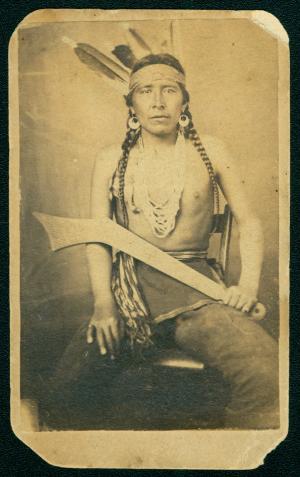 "There was great dissatisfaction among the Indians over many things the whites did. The whites would not let them go to war against their enemies. . . . Then the whites were always trying to make the Indians give up their life and live like white men--go to farming, work hard as they did--and the Indians did not know how to do that, and did not want to anyway. It seemed too sudden to make such a change. If the Indians had tried to make the whites live like them, the whites would have resisted, and it was the same way with many Indians. The Indians wanted to live as they did before the treaty of Traverse des Sioux--go where they pleased and when they pleased, hunt game wherever they could find it, sell their furs to the traders and live as they could."
"There was great dissatisfaction among the Indians over many things the whites did. The whites would not let them go to war against their enemies. . . . Then the whites were always trying to make the Indians give up their life and live like white men--go to farming, work hard as they did--and the Indians did not know how to do that, and did not want to anyway. It seemed too sudden to make such a change. If the Indians had tried to make the whites live like them, the whites would have resisted, and it was the same way with many Indians. The Indians wanted to live as they did before the treaty of Traverse des Sioux--go where they pleased and when they pleased, hunt game wherever they could find it, sell their furs to the traders and live as they could."
Wambditanka (Big Eagle), Mdewakanton Dakota leader, in an interview conducted with journalist Return I. Holcombe in 1894
Also known as Jerome Big Eagle, Wambditanka was born in 1827 at Black Dog’s village, a few miles above Mendota on the south bank of the Minnesota River. He succeeded his father, Grey Iron, as chief in 1857. By 1858 had moved to the Redwood (Lower Sioux) Agency to farm. When war broke out he joined the fighting and was at the battles of New Ulm, Fort Ridgely, Birch Coulee, and Wood Lake. After the war he was tried and convicted by the military commission, but received a pardon from President Lincoln in 1864. After several years living on reservations, Wambditanka and his family returned to Minnesota where he lived until 1906.
On the war of 1862:
"It began to be whispered about that now would be a good time to go to war with the whites and get back the lands. It was believed that the men who had enlisted [to fight in the Civil War] last had all left the state, and that before help could be sent the Indians could clean out the country, and that the Winnebagoes [Ho-Chunk], and even the Chippewas [Ojibwe], would assist the Sioux. It was also thought that a war with the whites would cause the Sioux to forget the troubles among themselves and enable many of them to pay off some old scores. Though I took part in the war, I was against it. I knew there was no good cause for it, and I had been to Washington and knew the power of the whites and that they would finally conquer us. We might succeed for a time, but we would be overpowered and defeated at last. I said all this and many more things to my people, but many of my own bands were against me, and some of the other chiefs put words in their mouths to say to me."
"I did not have a very large band. . . . Most of them were not for the war at first, but nearly all got into it at last. A great many members of the other bands were like my men; they took no part in the first movements, but afterwards did. . . . When I returned to my village that day I found that many of my band had changed their minds about the war, and wanted to go into it. . . . I was still of the belief that it was not best, but I thought I must go with my band and my nation, and I said to my men that I would lead them into the war, and we would all act like brave Dakotas and do the best we could. All my men were with me; none had gone off on raids, but we did not have guns for all at first."
Primary
Anderson, Gary Clayton and Alan R. Woolworth, Through Dakota Eyes: Narrative Accounts of the Minnesota Indian War of 1862. St. Paul, MN: Minnesota Historical Society Press, 1988.




